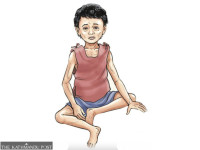National
Scrub typhus emerges as a major public health problem in Nepal
Over 16,000 people were infected with the potentially fatal disease last year as the parasite spread beyond rural areas.
Arjun Poudel
Patients with high fever and severe body aches, headache, abdominal pain, and joint and muscle pain are common in the outpatient department of Patan Hospital—and some of them have of late been testing positive for scrub typhus.
“Patients infected with scrub typhus visit the outpatient department of our hospital regularly for treatment,” said Dr Samita Panta Acharya, medical director at the Patan Hospital. “The number of scrub typhus infections have risen over the years.”
Scrub typhus, or bush typhus, is a potentially fatal infectious disease caused by the parasite Orientia tsutsugamushi, a mite-borne bacterium. It spreads to humans when bitten by infected chiggers (larval mites) found in mice.
Along with Patan Hospital, health facilities throughout the country have witnessed an uptick in the number of scrub typhus infections in the past few years.
According to data provided by the Integrated Health Information Management Section under the Department of Health Services, 16,597 people across the country were infected with scrub typhus in the fiscal year 2024-25. Of the total cases of infection, Lumbini Province recorded 4,322 cases, the highest number in the country, followed by Sudurpaschim province (3,746 cases), Karnali province (2,539), Koshi province (2,119), Bagmati Province (1,838), Gandaki province (1,725) and Madhesh province (308).
The number could be higher still, as all cases of infection do not enter government records.
What alarms health officials is that people living in urban settings are also getting infected with the deadly disease. Until a few years ago, it was believed that only those residing in rural areas or those working in grasslands or fields were at high risk.
“Scrub typhus has emerged as a major public health problem in Nepal,” said Gokarna Dahal, chief of the Vector Control Section at the Epidemiology and Disease Control Division. “People residing in both rural and urban settings are getting infected.”
Health officials say some people may have died from the infection, but doctors often fail to identify scrub typhus deaths as the cause since patients suffer other complications, including multi-organ failure.
Nepal saw a surge in scrub typhus cases after the calamitous 2015 earthquakes that killed nearly 9,000 persons across the country.
Three months after the quakes, the BP Koirala Institute of Health Sciences, Dharan, alerted the Epidemiology and Disease Control Division about six children with unusual fevers and severe respiratory problems.
Serum samples were collected for subsequent tests in Kathmandu and Bangkok, which confirmed a scrub typhus outbreak. By then, four children had already died in the course of the treatment. By the end of the year, 101 cases were confirmed in 16 districts, and four more people succumbed to the disease.
The magnitude of the outbreak escalated in 2016 when 831 cases of scrub typhus were reported in 47 districts, and 14 people had died by the end of that year.
According to the Ministry of Health and Population data, more than 1,026 people were infected with the disease in 2020. The number increased to 1,999 in 2021, and to more than 2,900 in 2022.
In 2023, over 5,000 people were infected.
Doctors say the risk of severity and fatality can be minimised if patients are diagnosed and treated early.
Common antibiotics, such as doxycycline and azithromycin, which are on the government’s essential drugs list and distributed free to health facilities across the country, can cure the disease.
However, what is concerning is that many health workers, including doctors, lack sufficient knowledge about diagnosing scrub typhus. Many health facilities also lack reagents to carry out tests for the disease.
Doctors can diagnose the disease based on the symptoms, but the risk of misdiagnosis is high, as scrub typhus symptoms are similar to those of other illnesses.
They warn that waiting for lab results before starting treatment could be dangerous. It can take about a week to get lab results and, by that time, the patient can fall into coma and suffer multi-organ failure.
Doctors point out high fever, headache, abdominal pain, backache, joint and muscle pain, red rash, nausea and vomiting as some of the symptoms of scrub typhus infection. Patients with severe illness may develop bleeding, which could lead to organ failure. The infection can lead to respiratory distress, inflammation of brain, lungs, kidney failure and then multi-organ failure. If not treated immediately, it can be fatal.




 6.12°C Kathmandu
6.12°C Kathmandu















